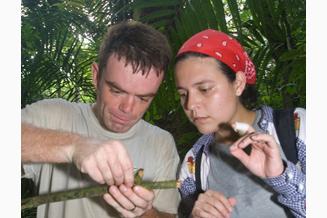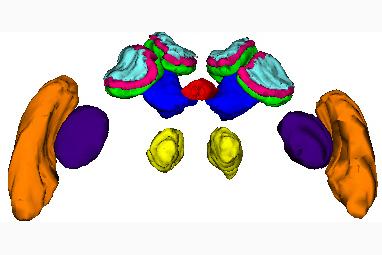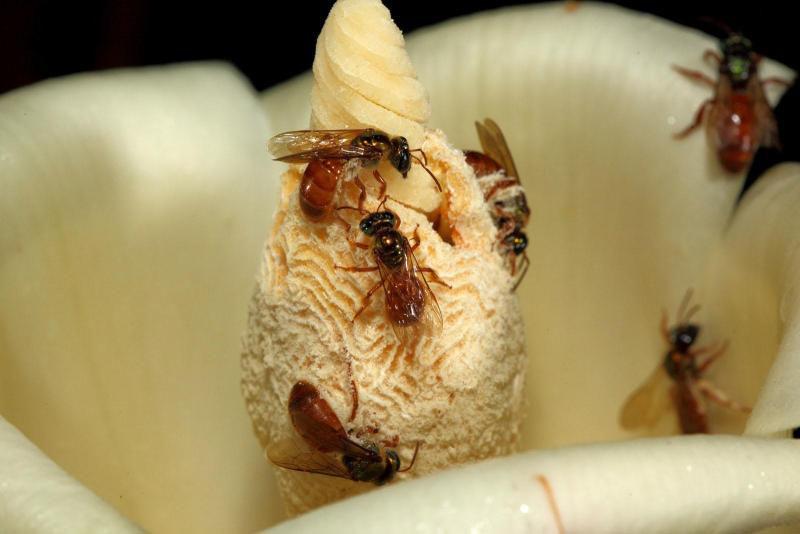Adam R. Smith

Adam R. Smith
Associate Professor of Biology
Systematics, Evolution & Ecology
Contact:
Expertise
Animal behavior, social insects, bees, ecology and evolution, tropical biology.
Why do some animals live in social groups where only one member reproduces? The research focus of my lab is the ecology and evolution of cooperative social groups, using social and solitary insects as research subjects. We study social insects because that is where the greatest diversity of social systems and social species are—plus they are endlessly fascinating in their own right! However, I am always open to projects in other areas of insect biology, or behavior of other taxa.
If you are a prospective undergraduate or graduate student interested in doing research in the lab, please email me! There are opportunities for pursuing projects in all of the research areas described below, or developing one around your own related interests.
One topic of our research is facultatively social species-- species in which a female can either nest solitarily (all offspring leave the nest to initiate their own nests) or eusocially (at least one daughter stays at the nest as a sterile worker, helping her mother—the queen—raise future offspring). These species allow us to directly study the transition from solitary to social. We use one such species, the neotropical halictid bee Megalopta genalis, to study both ecological questions (such as the effect of group living on offspring survival and predator defense) and physiological questions (such as the role of endocrine expression in decoupling parental care from reproduction) relevant to the transition from solitary life to cooperative social groups. This research is done on Barro Colorado Island, Panama, in collaboration with William Wcislo of the Smithsonian Tropical Research Institute. There we use observation nests in the field and collections of naturally occurring nests to study the bees’ biology in their natural habitat.
The facultative expression of sociality also allows us to integrate other aspects of the bees’ biology, such as parasitism, pollen foraging, and neurobiology, with their social behavior. Recent and ongoing projects examine the effect on pollen foraging (with or without actual pollination) of resource distribution, allowing us to take a more ecological approach to behavior. On the other hand, we are also studying the neurobiological and endocrine causes and consequences of social behavior, using both bees and ants as research subjects, to integrate behavior with development and physiology.
While our tropical work is ongoing, local bees also offer a wonderful diversity of social systems for study, from solitary nesters to large-colony social species—some are even parasites of other bees’ nests. We are currently planning projects with solitary species and bumblebee colonies, both in the lab and field.
Kapheim, KM, AR Smith, WT Wcislo, P Nonacs & RK Wayne. 2013. Foundress polyphenism and the origins of eusociality in a facultatively eusocial sweat bee, Megalopta genalis (Halictidae). Behavioral Ecology and Sociobiology 61: 331-340.
Smith, AR, KM Kapheim, B Perez, C Brent, WT Wcislo. 2013. Juvenile hormone titers are suppressed in foragers and elevated in queens of the facultatively social sweat bee Megalopta genalis. Hormones and Behavior 63: 1–4.
Smith, AR, IQ Lopez, JE Moreno, DW Roubik, & WT Wcislo. 2012. Pollen use by Megalopta sweat bees in relation to resource availability in a tropical forest. Ecological Entomology 37: 309-317.
Kapheim, KM, AR Smith, K Ihle, GV Amdam, P Nonacs, & WT Wcislo. 2012. Evidence of a physiological basis for caste evolution and developmental caste biasing in a facultatively eusocial sweat bee. Proceedings of the Royal Society Series B, 279: 1437-46.
KM Kapheim, SV Bernal, AR Smith, P Nonacs, & WT Wcislo 2011 Support for maternal manipulation of developmental nutrition in a facultatively eusocial bee, Megalopta genalis (Halictidae). Behavioral Ecology and Sociobiology, 65: 1179-1190.
Smith AR, MA Seid, L Jimenez, & WT Wcislo 2010 Socially induced brain development in the mushroom bodies of a facultatively social sweat bee Megalopta genalis. Proceedings of the Royal Society Series B. 277: 2157-2163.
Smith AR 2010 Invertebrate social behavior: developmental plasticity. In Breed MD and Moore J (eds) Encyclopedia of Animal Behavior, pp. 507-512. Oxford: Academic Press.
Smith, AR, KM Kapheim, S O’Donnell, & WT Wcislo 2009 Social competition but not subfertility leads to a division of labour in the facultatively social sweat bee Megalopta genalis (Hymenoptera: Halictidae). Animal Behaviour, 78: 1043-1050.
Kalka MB, AR Smith, & EKV Kalko 2008 Bats limit arthropods and herbivory in a tropical forest. Science. 320: 71.
Smith, AR, WT Wcislo, & S O’Donnell 2008 Body size shapes caste expression, and cleptoparasitism reduces body size in the facultatively eusocial bees Megalopta (Halictidae). Journal of Insect Behavior. 21: 394-406.
Smith, AR, WT Wcislo, & S O’Donnell 2007 Survivorship and productivity benefits to social living in the facultatively social sweat bee Megalopta genalis (Hymenoptera: Halictidae). Behavioral Ecology and Sociobiology. 61: 1111-1120.
Wcislo WT, L Arneson, DW Roubik, K Roesch, VH Gonzalez, AR Smith, & H Fernandez 2004 The evolution of nocturnal behavior in sweat bees, Megalopta genalis and M. ecuadoria (Hymenoptera: Halictidae): an escape from competitors and enemies? Biological Journal of the Linnean Society. 83: 377-387.
Smith AR, WT Wcislo, & S O'Donnell 2003 Assured fitness returns favor sociality in a mass-provisioning sweat bee, Megalopta genalis (Hymenoptera: Halictidae). Behavioral Ecology and Sociobiology. 54: 14-21.
Howard KJ, AR Smith, S O'Donnell & RL Jeanne 2002 Novel method of swarm emigration by the epiponine wasp, Apoica pallens (Hymenoptera: Vespidae). Ethology, Ecology and Evolution. 14: 365-371.
Smith AR, S O'Donnell, & RL Jeanne 2002 Evolution of swarm communication in eusocial wasps (Hymenoptera: Vespidae). Journal of Insect Behavior. 12: 751-764.
Smith AR, S O’Donnell & RL Jeanne 2001 Correlated evolution of colony defense and social structure: a comparative analysis in eusocial wasps (Hymenoptera: Vespidae). Evolutionary Ecology Research. 3: 331-344.
Chang G & AR Smith 1999 Book Review: Phenotypic Evolution, a Reaction Norm Perspective, by C.D. Schlichting & Massimo Pigliucci. Animal Behaviour. 57: 1169-1170.
B.A., Biology, Williams College
Ph.D., Animal Behavior, University of Washington
Postdoctoral Fellow, Smithsonian Tropical Research Institute, Panama
Postdoctoral Fellow, University of Leeds, UK





